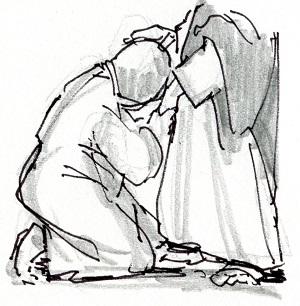

“Lord, if you had been here, my brother would not have died” (John 11:20).
Saints Martha, Mary and Lazarus
This feast, which now includes Mary and Lazarus, was once devoted to just Martha, and she is my focus today. Martha is like Thomas the doubter and Philip the pragmatist in that she confronted Jesus with the hardest question of all: If God loves us so much, why do we suffer and die?
Her question, part of the scene in the story of the death of Lazarus, her brother, is the underlying challenge of every funeral, when this same reading is often proclaimed and preached from. Survivors have prayed fervently and with faith for a beloved friend or family member who nonetheless has died. "Lord, why didn’t you save him?" "Where were you when we begged that she recover?"
Martha exemplifies the five stages of grief described by Elizabeth Kubler Ross in her book, Death and Dying: Denial, Anger, Bargaining, Depression and Acceptance. Grief is not a moment but a process, a stage-by-stage struggle that either paralyzes us or brings us deeper into the mystery of our human fragility before the ultimate mercy of God, who did not spare Jesus from experiencing death as a necessary part of the full journey through time into eternity.
In the fourth Gospel, Jesus seemingly delays going to his sick friend, Lazarus. When he does go, Lazarus is already in the tomb. Martha goes out to meet Jesus, an initiative that reflects her prayer as bold confrontation: “Why didn’t you come?” Jesus reassures her that the death of her brother is part of something much greater and more astonishing than any human loss. He weeps at the tomb as the loss of his friend grips him.
The story occasions one of the final “signs” that form the structure of the fourth Gospel, each one culminating in an I AM declaration by Jesus that reveals his divine identity. I AM, the name given to Moses at the burning bush, is who Jesus is –I AM the living water, the light of the world, the Good Shepherd, the Bread of Life, the Way the Truth and the Life, and now “the Resurrection and the Life. Each sign prepares believers for the final sign of his death on the cross, the “lifting up of the son of man,” and his resurrection as the Lord of Glory.
St. Martha accompanies us through the stages of grief to an encounter with the One who has power over life and life. If Martha confronts Jesus, he also confronts her: “Do you believe this?” Only faith can bring us through the dark night of doubt to the dawn of new hope, the New Creation that will someday bring each of us face to face with the Living God.
Advertisement






